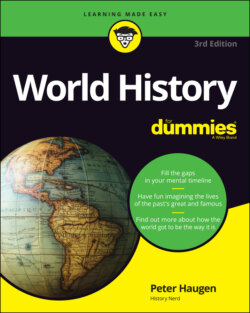Читать книгу World History For Dummies - Peter Haugen - Страница 90
Roaming eastward
ОглавлениеEmperors ran Rome for hundreds of years more as dynasties and factions rose and fell, and as pressure along the far-flung borders demanded vigilance. (For more on Roman defensive strategies, see Chapter 16.) Successive Roman emperors concentrated resources along the eastern frontier formed by the Danube River, which flows from today’s Germany to the Black Sea.
In the third century AD, the Emperor Diocletian, a soldier from Croatia who was trying to restore order after a period of internal revolt, tried splitting the empire in two:
East: He took the wealthy, relatively healthy eastern lands, which he ruled from a new capital where Izmit, Turkey, is today.
West: He tapped the general in charge of Gaul, Maximian, to rule the western half of the Roman Empire from the city of Rome.
Both Diocletian and Maximian had the title Augustus, and two more co-rulers, Constantius and Galerius, received the lesser title Caesar.
When Constantius died, his son, Constantine, later called Constantine the Great, succeeded him and eventually won control of the whole empire. The reunification couldn’t last, though, especially considering that Constantine based himself in the east too. He built what he called New Rome at the site of the old seaport of Byzantium on the Bosporus, the channel that connects the Black Sea with the Sea of Marmara and in turn the Mediterranean. Completed in 330 AD, New Rome was renamed Constantinople that year. Today, the city is called Istanbul.
One result of the power shift away from Rome was that the Roman Senate was sometimes relegated to the status of a city council. True, Rome was quite a city for a council to oversee, but the power was where the emperor was (or the emperors were). Rome’s western half became less and less an empire and therefore grew more and more vulnerable to invasion by the barbarian tribes from the north: Huns, Vandals, Visigoths, Ostrogoths, and more.
By 400 AD, Theodosius had a senate in Constantinople and a staff of 2,000 bureaucrats. Also around this time, Roman tax collectors could no longer move about Europe without military escorts. The Visigoths sacked Rome in 410 AD.
